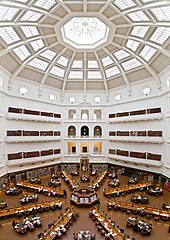

Education in Victoria, Australia is supervised by the Department of Education and Training, which is part of the State Government and whose role is to "provide policy and planning advice for the delivery of education".[1] It acts as advisor to two state ministers, that for Education and for Children and Early Childhood Development.
Education in Victoria follows the three-tier model consisting of primary education (primary schools), followed by secondary education (secondary schools or secondary colleges) and tertiary education (universities and TAFE Colleges).
School education is compulsory in Victoria between the ages of six and seventeen.[2] A student is free to leave school on turning seventeen, which is prior to completing secondary education. In recent years over three-quarters of students are reported to be staying on until they are eighteen[citation needed], at the end of the secondary school level. Government schools educate 64% of Victorian students, with 21% of students in Catholic schools and the remaining 15% in independent schools as of 2021.[3]
Education in government schools until year 12 is free, but this does not apply to overseas students nor to students over the age of 20 on 1 January of the year of enrolment.[4] Independent schools, both religious and secular, charge fees, which are subsidised by the Federal and State governments.
Although non-tertiary public education is free, 36% of students attend a non-government school as of 2021.[3] The most numerous private schools are Catholic, and the rest are independent (see Public and Private Education in Australia). As of 2021, there were 1553 government schools, 497 Catholic schools and 226 independent schools in Victoria.[3]
Regardless of whether a school is government or independent, they are required to adhere to the same curriculum frameworks. Education in all government schools is secular and must not promote any particular religious practice, denomination or sect.[5] Most school students, be they in a government, Catholic or independent school, usually wear uniforms, although there are varying expectations and some schools do not require uniforms.
Post-compulsory education is regulated within the Australian Qualifications Framework, a unified system of national qualifications in schools, vocational education and training (TAFE) and the higher education sector (university).
The academic year in Victoria generally runs from late January until mid-December for primary and secondary schools and TAFE colleges, and from late February until mid-November for universities. Victorian schools operate on a four term basis. Schools are closed for the Victorian public holidays.[6] Universities observe the Commonwealth public holidays.
- ^ Department of Education and Early Childhood Development. "About the Department". education.vic.gov.au. Archived from the original on 29 May 2012. Retrieved 18 July 2008.
- ^ Education and Training Reform Act 2006, sec. 2.1.1
- ^ a b c "Summary statistics for Victorian Schools July 2021" (PDF). Department of Education and Training. July 2021. Retrieved 4 June 2024.
- ^ Education and Training Reform Act 2006, sec. 2.2.4
- ^ Education and Training Reform Act 2006, sec. 2.2.10
- ^ "School term dates and holidays in Victoria". www.vic.gov.au. 15 April 2024. Retrieved 4 June 2024.
© MMXXIII Rich X Search. We shall prevail. All rights reserved. Rich X Search
